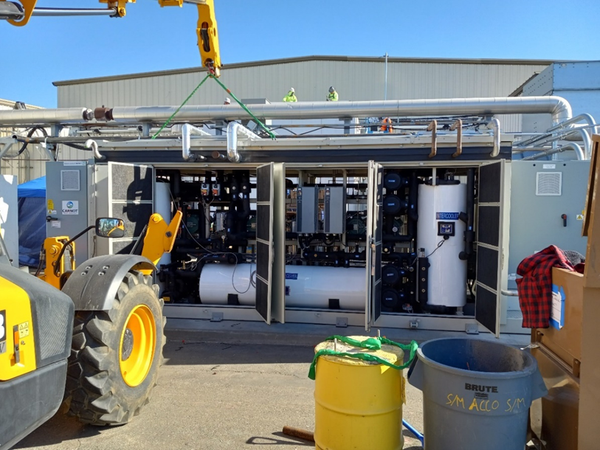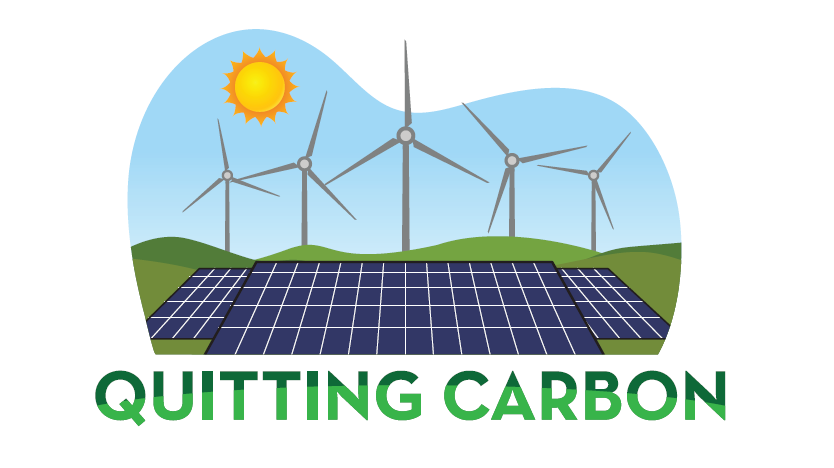What I’m reading: California's cleaner grid, UK and Poland energy transitions, research roundup, and more

Quitting Carbon is a 100% subscriber-funded publication. To support my work, please consider becoming a paid subscriber or making a one-time donation.
It’s wonderful to have so many new readers subscribe to Quitting Carbon since my last roundup. For those of you who are receiving this newsletter for the first time, welcome!
I publish these bi-weekly roundups to highlight important energy transition updates and trends you might have missed or that didn’t get much coverage elsewhere in the media. Please help spread the word about Quitting Carbon by sharing this newsletter with anyone in your life who is as much of an energy nerd as all of us are.
These roundups typically arrive in your inbox on Fridays, but I was under the weather at the end of last week, hence the delay. Thanks, as always, for reading.
100% clean energy is powering California more each day
It is well known that California is a world leader in clean energy. Even so, I think many people would be surprised to learn just how quickly the world’s fourth-largest economy is transitioning to a zero-carbon grid.
“More than 9 out of 10 days so far this year have been powered by 100% clean energy for at least some part of the day in California. In 2025, California’s grid has run on 100% clean electricity for an average of 7 hours a day,” according to a press release issued by the Office of Governor Gavin Newsom (D) on July 10.
California added approximately 7,000 megawatts of clean energy to its grid last year, “representing the largest single-year increase in clean energy capacity added to the grid in state history.”
And much more clean energy is on the way.
Last month, the California Energy Commission approved the Darden Clean Energy Project. Located in Fresno County, the project includes 1,150 megawatts (MW) of solar power capacity and up to 1,150MW (4,600 megawatt-hours) of battery storage – it will be “the largest battery energy storage system in the world,” according to the CEC.
The project is the first to be permitted under an opt-in streamlined certification process for clean energy projects established by AB 205 in 2022.
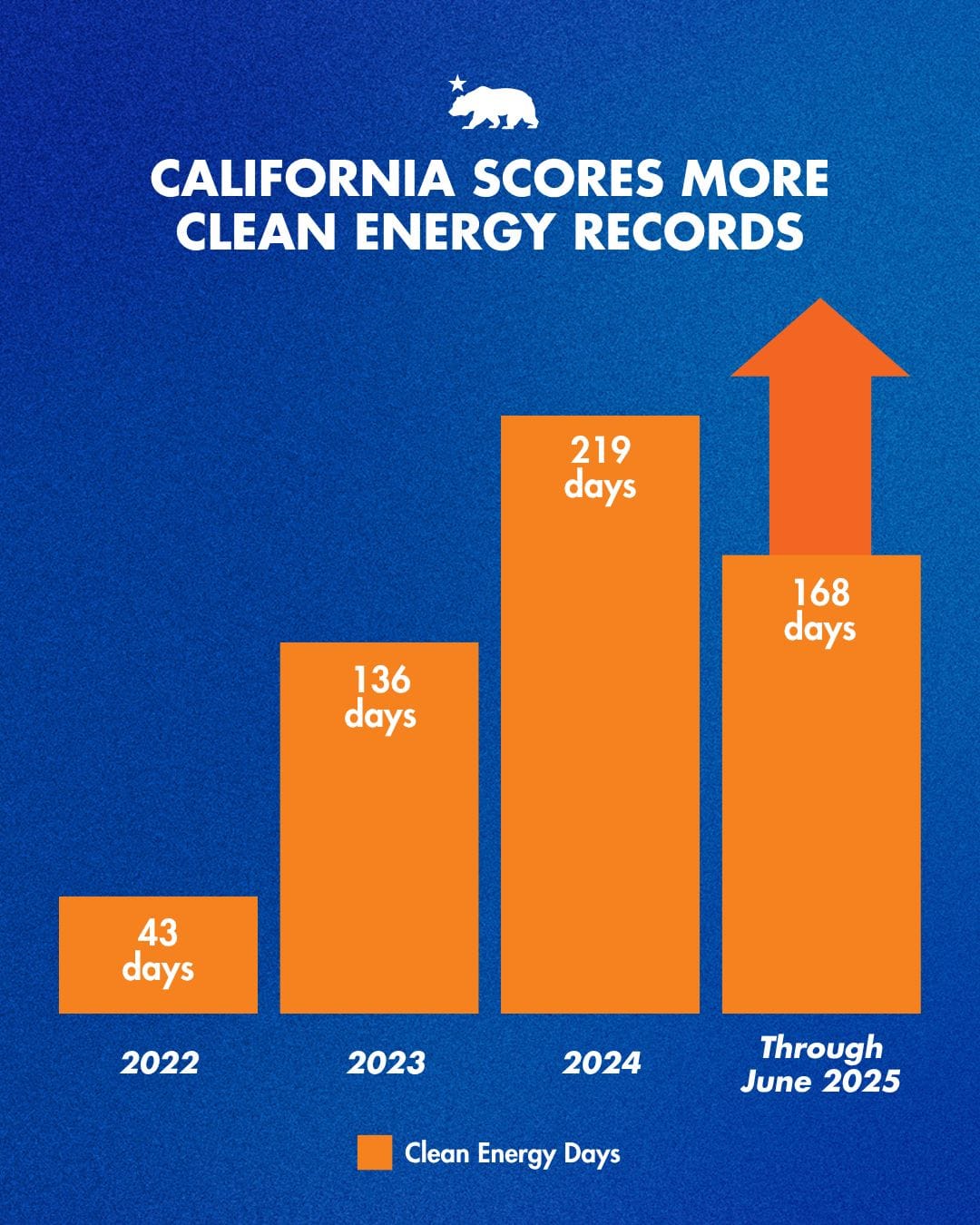
After Labour’s first year, checking in on the UK’s energy transition

It has been one year since Keir Starmer’s Labour government took power in the UK, so I thought it would be a good time to check in on recent energy transition milestones in the country. There have been some setbacks – the government recently refused to back the Xlinks project, which would have sent solar power from Morocco to the UK via subsea cables, for example – but the overall trendlines for the UK’s net-zero transition are positive.
Solar: I’ve written here about recent moves by Labour to boost solar deployment. The government promised new rules that would mandate rooftop solar panels for new homes in England, said it may require solar to be installed at car parks, and signaled it would legalize balcony solar installations.
The government released a Solar Roadmap at the end of June that outlines the steps required to increase the UK’s installed solar capacity from a little more than 18 gigawatts (GW) today to 45 to 47GW by 2030.
At the beginning of this month, developers turned on the UK’s largest solar farm, the Cleve Hill Solar Park. The 373 megawatt (MW) facility, the first solar and battery storage project to be approved as a Nationally Significant Infrastructure Project, is more than four times larger than the next largest UK solar project, reports BusinessGreen’s Stuart Stone. The UK set a solar generation record of 14GW after midday on Tuesday, July 8, with solar accounting for 40% of the electricity mix.
EVs: The UK has recently become one of the world’s best-performing EV markets. In June, electric models accounted for a record 25% of new car sales. And EVs’ market share is set to jump higher after the government revived the UK’s grant scheme last week. “Drivers across the UK will soon be able to take advantage of discounts worth up to £3,750 [$5,028] on dozens of new electric vehicle (EV) models, after the government today announced a new £650m fund designed to encourage more motorists to switch to zero emission cars,” reported Stone.
Wind and steel: The UK has long been a world leader in offshore wind. Recent moves by the government aim to accelerate deployment in the sector.
Ed Miliband, the UK’s Secretary of State for Energy Security and Net Zero, said earlier this month that the state-owned Great British Energy “is weighing up multimillion pound stakes in six floating offshore wind projects,” reported Politico’s Charlie Cooper. “If given the go-ahead, these projects would likely represent the firm's biggest intervention in the U.K. renewables market to date.”
And last week, the government announced reforms ahead of the upcoming round of its Contracts for Difference (CfD) scheme for renewable energy procurement. Among the changes were extending the term of CfD payouts from 15 to 20 years, allowing applications from offshore wind projects without full planning approval, and permitting applications from onshore wind repowering projects, as reported by Carbon Brief’s Simon Evans on Bluesky.
Also last week, Tata Steel started construction on a £1.25bn electric arc furnace project at the Port Talbot steelworks site in South Wales. “The project has secured £500m of government backing and is set to be commissioned at the end of 2027,” reported BusinessGreen’s Amber Rolt. “Once operational it is expected to reduce Port Talbot's carbon emissions by around 90 per cent compared to its previous operations, delivering emissions savings of five million tonnes of CO2 a year, which are equivalent to around 1.5 per cent of the UK's total direct CO2 emissions.”
Labour cannot take credit for all these milestones. The Tories had been in power for the previous 15 years before Keir Starmer’s victory, after all. But by reinvigorating the UK’s energy transition, Labour appears to be nudging the country towards achieving its long-term climate goals.
“The UK government’s official climate advisers are now ‘more optimistic’ that the country can hit its emissions targets than they were before the Labour government was elected in July 2024,” a team at Carbon Brief wrote last month ahead of the launch of the Climate Change Committee’s 2025 progress report.
Europe’s coal heartland is turning to solar and offshore wind
For decades, Poland has been at the heart of Europe’s coal economy, with the fuel dominating its energy mix. But that’s beginning to change.
Poland recorded its highest-ever solar power contribution at a little more than 20% last month, according to data from the Ember think tank. Contributions from solar and wind pushed coal’s share of Poland’s power mix to a record low (42.9%) in June.
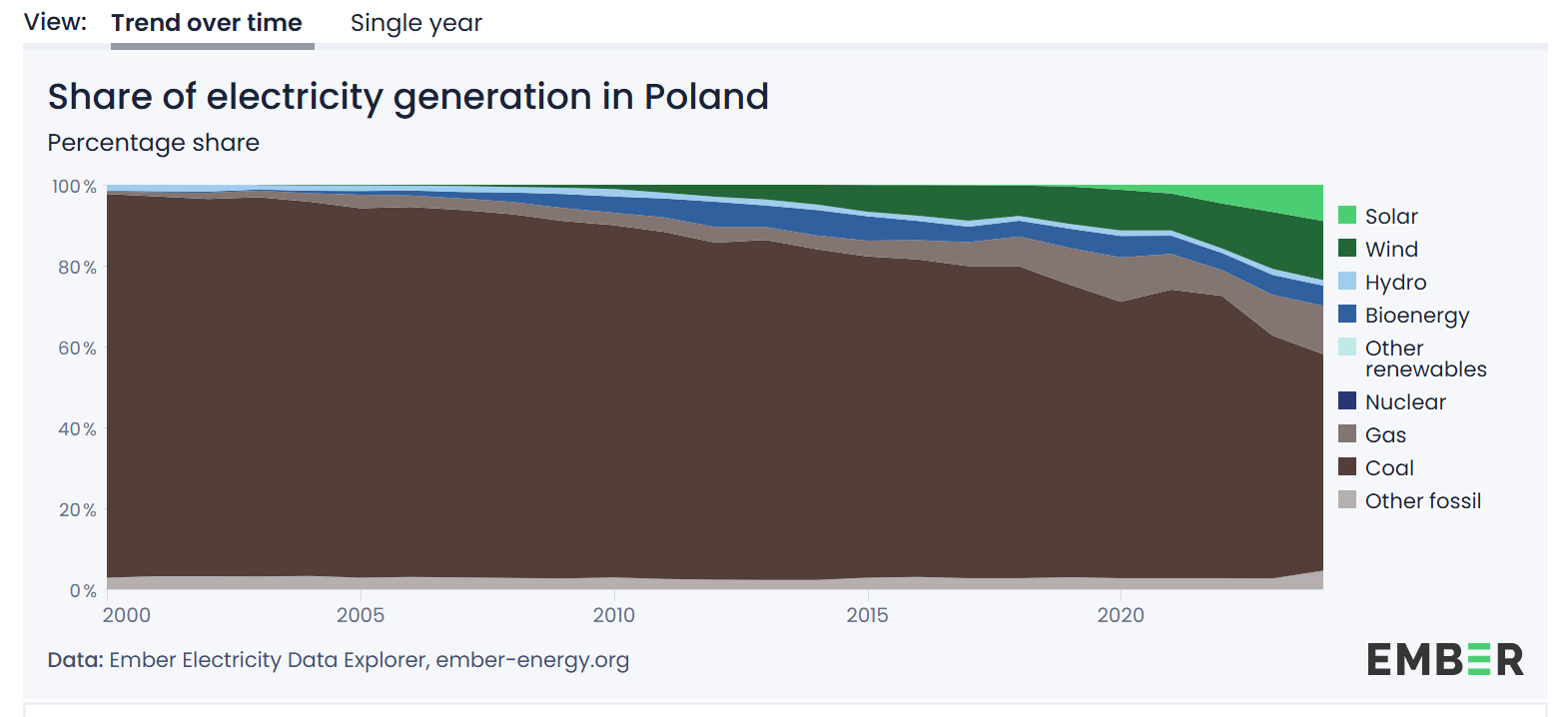
Earlier this month, the developers of Baltic Power, Poland’s first offshore wind farm, installed the first of 76 Vestas 15-megawatt turbines. Baltic Power is expected to be commissioned in 2026.
“With a capacity of 1.2 GW, the Baltic Power wind farm will generate 4 TWh of electricity annually, covering three per cent of Poland’s energy demand and powering over 1.5 million households, while reducing CO2 emissions by approximately 2.8 million tonnes per year, according to the developer,” Adnan Memija reported at OffshoreWIND.biz.
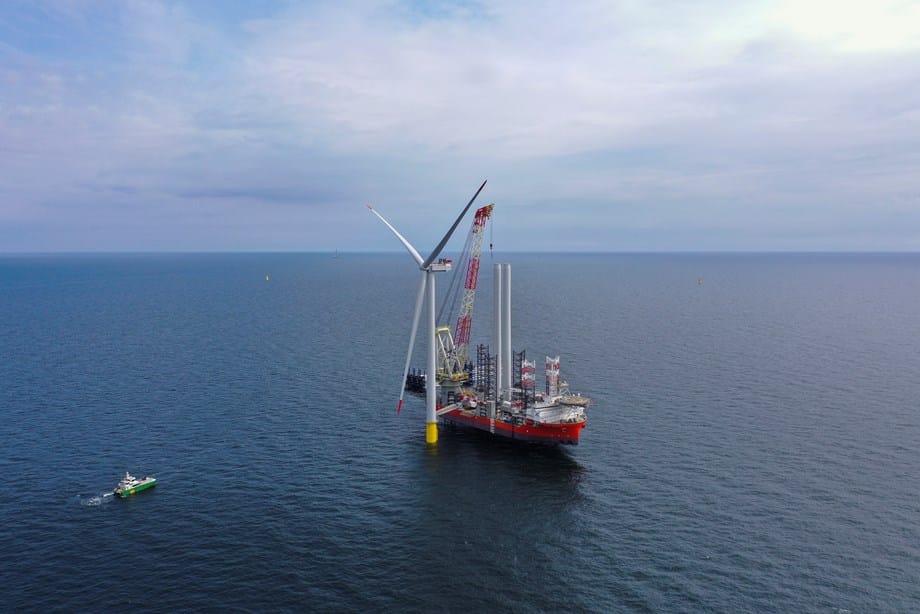
Research roundup
More announcements for reports and studies arrive in my inbox each day than I could cover in multiple lifetimes. Here are several recent reports that merit your attention:
Cheap window heat pumps: A new study from the American Council for an Energy-Efficient Economy (ACEEE) finds that “window-mounted heat pumps now provide a lower-cost option than any previous technology” for apartment buildings. “Heat pumps – especially cutting-edge technologies like window-mounted models – offer the most cost-effective and scalable way to fully decarbonize heating in apartment buildings,” said Steven Nadel, executive director of ACEEE and the study’s lead author, in a statement.
EVs are cleaner than ICE cars and getting cleaner: “Europe’s electricity mix is getting cleaner, and with it, the climate advantage of electric cars is growing,” finds new research from the International Council on Clean Transportation. “Battery electric cars sold today produce 73% less life-cycle greenhouse gas emissions than their gasoline counterparts – even when factoring in production. That’s a 24% improvement over our 2021 estimates. In contrast, other powertrains, including hybrids and plug-in hybrids, show only marginal or no progress in reducing their climate impacts.”
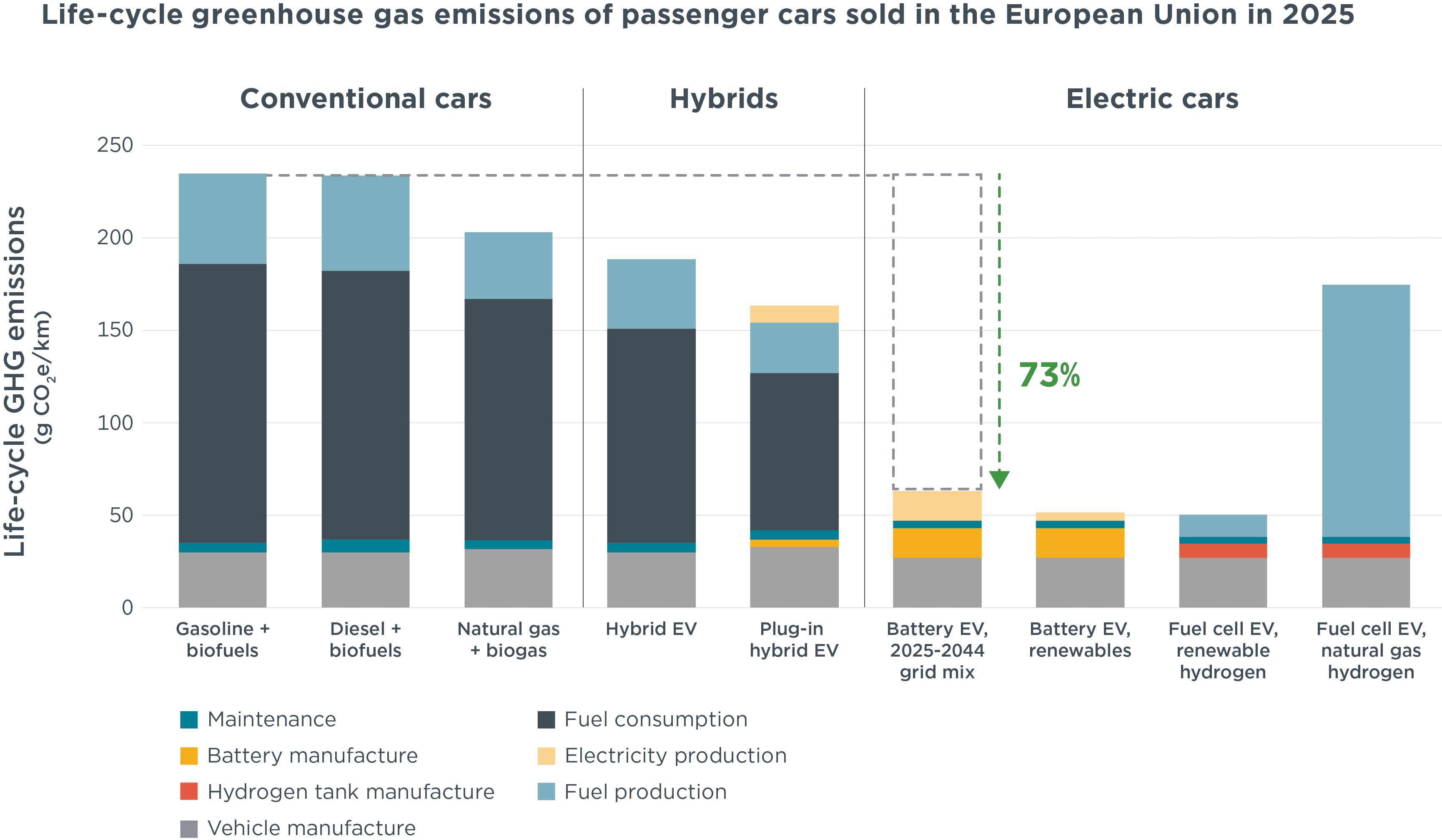
Germany’s agrivoltaics potential: In a previous newsletter, I highlighted the agrivoltaics boom underway here in the U.S. The Fraunhofer Institute for Solar Energy Systems recently completed an evaluation of Germany’s agrivoltaics potential. “Some 500 gigawatts (GW) of peak solar power capacity could be installed on Germany’s agricultural land – 100 GW over the country’s 2040 photovoltaic expansion targets.” The study is the first of its kind in Germany to consider all types of agricultural land, according to Fraunhofer ISE, as reported by Clean Energy Wire.
Here’s what the Republicans’ budget reconciliation bill means for the U.S. energy economy: “We estimate the law will increase national average household energy bills by $78-192 and increase total industrial energy expenditures by $7-11 billion in 2035,” finds an analysis published recently by the Rhodium Group think tank. “The OBBB will cut the build-out of new clean power generating capacity by 53-59% from 2025 through 2035. All told, the law puts more than half a trillion dollars of clean energy and transportation investment at risk of cancellation.”


